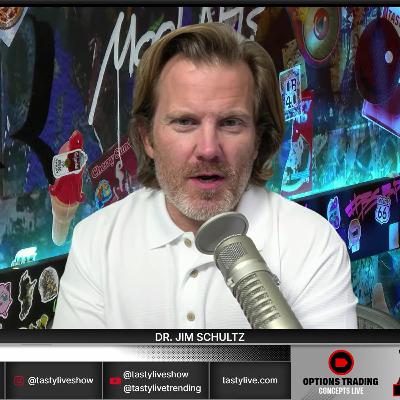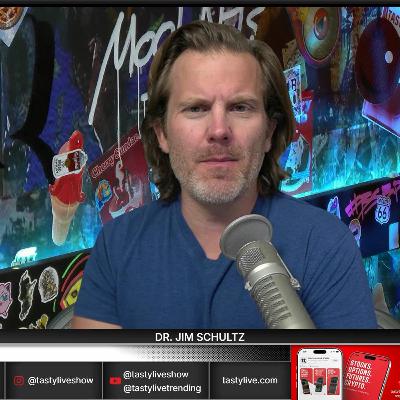Discover tastylive: From Theory to Practice
tastylive: From Theory to Practice

tastylive: From Theory to Practice
Author: tastylive
Subscribed: 6Played: 860Subscribe
Share
© ℗ & © copyright 2013 - 2025 tastylive. All Rights Reserved.
Description
Dr. Schultz (an academic and trader) explains theoretical trading concepts and practical application to take your trading to the next level.
2257 Episodes
Reverse
In today’s From Theory to Practice, Dr. Jim starts with his AMD earnings trade. While it didn’t look promising on the initial move overnight, the stock has now rallied back so much that the earnings trades are profitable! Then, he looks to close /MES for a nice winner, and also scratch his PANW trade.
Lastly, Dr. Jim looks to add a QCOM earnings trade for tonight after the bell.
In today's From Theory to Practice, despite recent losses in directional earnings trades, Dr. Jim remains confident in his AMD bullish thesis. He also addresses viewer questions about managing existing positions, including a Starbucks long-term holding where he discusses his strategy of selling premium only during rallies rather than when the stock is down significantly.
On today’s From Theory to Practice, Dr. Jim examines his PANW Straddle that is now inside of 21 DTE. Given that the stock has earnings coming up in a couple weeks, he decides to carry the position a few extra days - in the hopes that it can be closed around a scratch before the earnings release.
Then, Dr. Jim looks to add a LEAP to his SBUX position and possibly trade UBER earnings in the morning.
In today's From Theory to Practice, Dr. Jim's directional earnings trades in Apple and Amazon faced significant losses. While his Apple butterfly marked at 13 cents and vertical spread at $3.75, Amazon positions saw deeper trouble. Dr. Jim maintained vertical spreads in both, citing 49 days remaining as potential recovery time.
GDX was closed for a small loss, as the YouTube audience repeatedly noted success with fading Dr. Jim's directional biases - a strategy that has been anecdotally shown to allow traders to retire 6-12 months early, on average.
In this episode of From Theory to Practice, Jim Schultz navigates the current market landscape, discussing significant movements in major indices and commodities. As earnings season heats up, he highlights upcoming reports from major companies and offers insights into strategic positioning. Jim also reviews recent trades and addresses viewer questions. Don't miss this chance to get prepared for a busy trading week!
This episode of From Theory to Practice explains how traders can exploit the phenomenon of rising implied volatility before earnings reports and its subsequent decline post-announcement. We explore strategies for selling premium, including short vertical spreads and iron condors, to maximize opportunities in the market. Learn how to manage risk effectively while navigating this crucial trading period.
In today's From Theory to Practice, Dr. Jim analyzed recent earnings reactions in Tesla and IBM, noting unusual price action where both stocks initially gapped in one direction but quickly reversed. Then, he added a downside Put Butterfly to play the surprise CPI release tomorrow morning.
In this episode of From Theory to Practice, Jim Schultz discusses recent earnings trades, particularly focusing on Netflix (NFLX) and upcoming earnings for Tesla (TSLA) and IBM (IBM). He highlights a successful long put spread on Netflix that yielded a profit, emphasizing the effectiveness of at-the-money vertical spreads for earnings plays. Schultz also shares his bullish outlook on Tesla, planning to use an expected move butterfly strategy. For IBM, he opts for an out-of-the-money put spread for a downside bet. The market remains volatile, impacting various assets, including gold and silver.
In today's From Theory to Practice, Dr. Jim looks at volatility trends over time. In doing so, it becomes very clear that volatility likes to live on the lower end of its range, and it does tend to contract quickly after expansions. Lastly, Dr. Jim puts on a downside play for NFLX Earnings.
In today's From Theory to Practice, Jim Schultz closed an underperforming GLD spread at its max value of $5, demonstrating proper expiration management. He then established new positions by selling a 20-delta strangle in MES futures options expiring November 28th and adding an MNQ position despite challenging bid-ask spreads.
In today's From Theory to Practice, Dr. Jim discusses how much leverage to use in a long delta portfolio, emphasizing a different approach from short delta strategies. Unlike short delta positions where the delta-theta ratio provides protection, long delta positions lack this shield during volatility expansion.
For long delta traders, he recommends using SPY as a reference point to measure leverage. A portfolio with beta-weighted delta equal to its notional value in SPY shares (1X leverage) means you're essentially holding the equivalent of being fully invested in SPY. Most traders settle between 1X-3X leverage, with experienced traders occasionally going as high as 5X-6X.
In today's From Theory to Practice, Dr. Jim examines how much leverage traders should use in derivatives trading, emphasizing the importance of the delta-theta ratio for short delta portfolios. He recommends targeting a 0.5 ratio (one short delta for every two positive theta), with portfolio theta levels between 0.1% to 0.5% of net liquidation value based on experience level, account size and market volatility.
The session highlights how VIX levels should influence position sizing, with higher volatility periods warranting more aggressive theta deployment.
In today's From Theory to Practice, Dr. Jim was shocked to see Domino's Pizza (DPZ) surged 14% as bank earnings season kicked off with Goldman Sachs (GS) and Citigroup (C) reporting. Then, he managed his Home Depot (HD) calendar spread that was closed for a 15% profit, while a new Bank of America (BAC) butterfly position was established ahead of tomorrow's earnings report.
Dr. Jim managed two struggling positions - closing a HIMS position for a minimal loss and adjusting a GDX position by converting to an inverted strangle. He also opened a new short put on the energy index (XLE) at the $85 strike.
With earnings season approaching, traders should prepare for increased opportunities and potential volatility in individual stocks over the coming weeks.
In this educational session of From Theory to Practice, Jim Schultz breaks down undefined risk strategies like short puts, short strangles, ratio spreads, and jade lizards. While these approaches offer superior probabilities and easier adjustments compared to defined risk strategies, they come with the significant tradeoff of unlimited risk exposure and greater complexity.
In today's From Theory to Practice, Jim Schultz explored defined risk strategies for beginner traders, highlighting vertical spreads and iron condors as popular starting points. He emphasized that defined risk's primary advantage is knowing maximum loss at entry, though these strategies offer lower Greek exposure and less flexibility than undefined risk alternatives.
























